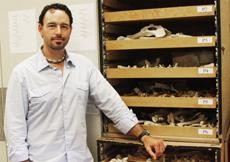UA assistant professor James Watson will travel to Chile on March 11 to study the teeth of the world’s oldest mummies.
Watson, an assistant professor of anthropology and assistant curator of bioarchaelogy at the Arizona State Museum, will spend four months in Chile studying the oral health of the 8,000-year-old Chinchorro culture, one of the first known populations to mummify its dead.
“”It was a family deal; they would mummify family members and reconstruct the body,”” Watson said. “”They would actually live with their ancestors. When their house got too full of mummies, they would bury some, so we found they would bury mummies in family groups. We would sometimes find a male, a female, sometimes a child or two.””
Watson was awarded a Fullbright grant, designed to fund international exchange. In Chile, he will study a collection of thousands of mummies, as well as teach an intensive workshop on dental anthropology at the Universidad Tarapaca de Arica. “”The thing that I love most is trying to understand who these people were in the past; what their lives were like, what they did, what affected their lives. My main interest is disease in the past, in this case oral disease. These diseases still affect us today, so they have very important implications for modern populations as well. It has real world applications. I’m really excited,”” Watson said.
Watson studies oral health in prehistoric populations, and focuses on understanding past diets and resulting mouth diseases such as cavities and tooth loss. He has done similar research in northern Mexico for the past 10 years.
“”I’ve been excavating skeletons from an eroded archaeological site, where the skeletons are up to 4,000 years old,”” Watson said. “”I’ve been looking at their teeth and seeing what the impact of agriculture, for example corn, has on their teeth.””
The types of things people ate in the past would cause different patterns of disease, Watson said.
“”The Chinchorro culture is along the Pacific Coast, and the interesting thing is that the diet is so different. They don’t have rich carbohydrates, so instead what they’re mostly subsisting on is seafood, more than anything,”” Watson said. “”They were eating a totally different diet, so what we expect is that the effect on the teeth is going to be totally different than it is here.””
In studying the Chinchorro culture, Watson said he expects there to be very few cavities or lost teeth in the mummies.
“”A lot of this will provide a comparative sample; seeing how the differences play out in the teeth, diet and people there will be interesting,”” Watson said.
Watson said there is a lot to learn and see and he hopes he will be able to have students accompany him in the future.
“”There’s so many mummies there, so there’s always new techniques and plenty of new hypothesis to test out on them. What I’m hoping is that with the material I collect and the research I do while I’m down there, it will provide the basis for bringing students down there.””
Watson’s wife, who is also an archaeologist, and their six-month-old son, will be accompanying Watson to Chile.
He said he will be doing more than just looking into the mouths of mummies; he will be looking into a past that is over 8,000 years old.









